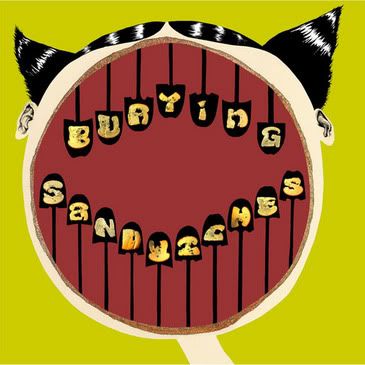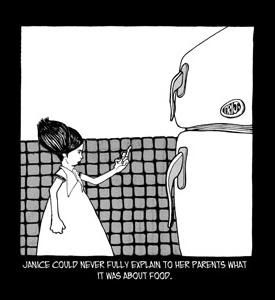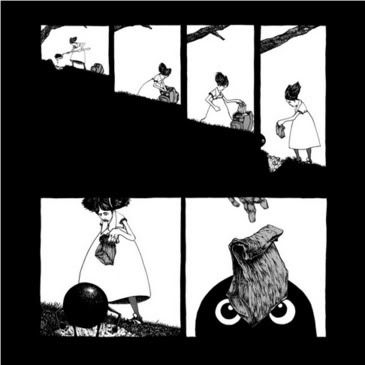APE Decompression: Burying Sandwiches
See, part of why I've been waiting to review Rob Sato's incredible Burying Sandwiches is because it's easily my favorite new book of APE 2006. But another part is that I've got almost no idea what to write about it. It's just really fucking good.

Burying Sandwiches is the tale of Janice Takeda, who "from the beginning... hadn't cared much for food." The story follows her from early childhood up through her early adulthood, wrestling the entire time with here intense dislike of eating.

We get snapshots of Janice's troubles throughout childhood, a tense anxiety building and building, until finally, at the age of nine, she determines a solution: she just plain won't eat anymore. She begins burying her lunches in a hole in the ground behind some old shed, alone and desperate.
It's at this point that the ghosts show up.

Fans of Sam Kieth's classic, The Maxx, will begin to recognize some similar motifs. Janice builds her own private life all around the ghosts, who through an especially chilling sequence prove to hold the solution to her problems with food. I'm reminded of The Outback and the blind little Isz creatures in Kieth's work. There's a level of fantasy and surrealness to the solution the ghosts provide, and this lends the second half of the story an incredible feeling of uncertainty and unpredictability, which is unusual for a story that reads - as this does - so much like a fairy tale.


A big draw for me - the factor that, fortunately, compelled me to buy the book when Molly picked it up and showed it to me - is the artwork. Sato's style is completely his own and it's fascinating. It also suits perfectly the story's unique combination of innocent imagination and stark, chilling consequence.
Every single page of this story stimulated my imagination, with just enough details left out that I could read some of my own interpretations into the tale. On one level, it's a fascinating take eating disorders, a subject in which I normally have little interst. On another level, it's about isolation, about being different from other people in ways we can't help, and what we'll do when that makes us desperate. The ending leaves me with a lot of questions, but mostly it just leaves me thinking.
I don't think I've put down a book with such a feeling of interest in quite a while.
Sato's website features several preview pages and information on distribution (including a direct link to the Last Gasp entry). I cannot recommend enough that you give it a look.

Burying Sandwiches is the tale of Janice Takeda, who "from the beginning... hadn't cared much for food." The story follows her from early childhood up through her early adulthood, wrestling the entire time with here intense dislike of eating.

We get snapshots of Janice's troubles throughout childhood, a tense anxiety building and building, until finally, at the age of nine, she determines a solution: she just plain won't eat anymore. She begins burying her lunches in a hole in the ground behind some old shed, alone and desperate.
It's at this point that the ghosts show up.

Fans of Sam Kieth's classic, The Maxx, will begin to recognize some similar motifs. Janice builds her own private life all around the ghosts, who through an especially chilling sequence prove to hold the solution to her problems with food. I'm reminded of The Outback and the blind little Isz creatures in Kieth's work. There's a level of fantasy and surrealness to the solution the ghosts provide, and this lends the second half of the story an incredible feeling of uncertainty and unpredictability, which is unusual for a story that reads - as this does - so much like a fairy tale.


A big draw for me - the factor that, fortunately, compelled me to buy the book when Molly picked it up and showed it to me - is the artwork. Sato's style is completely his own and it's fascinating. It also suits perfectly the story's unique combination of innocent imagination and stark, chilling consequence.
Every single page of this story stimulated my imagination, with just enough details left out that I could read some of my own interpretations into the tale. On one level, it's a fascinating take eating disorders, a subject in which I normally have little interst. On another level, it's about isolation, about being different from other people in ways we can't help, and what we'll do when that makes us desperate. The ending leaves me with a lot of questions, but mostly it just leaves me thinking.
I don't think I've put down a book with such a feeling of interest in quite a while.
Sato's website features several preview pages and information on distribution (including a direct link to the Last Gasp entry). I cannot recommend enough that you give it a look.

7 Comments:
At 11:09 PM, Unknown said…
Unknown said…
mcm bags
burberry outlet
oakley sunglasses
ray ban wayfarer
true religion jeans, http://www.truereligionjeansoutlet.com
vibram fivefingers
lacoste polo shirts
minnesota vikings jerseys
nike free 5.0
new york giants jerseys
kate spade outlet
true religion outlet, http://www.truereligionoutletstore.us.com
dansko outlet
cheap jordans
kate spade outlet
herve leger
adidas outlet
thomas sabo uk
chanel 2.55
beats headphones
kobe 9 elite
abercrombie
valentino outlet
cartier watches
instyler ionic styler
converse all star
puma sneakers
michael kors uk outlet
cheap toms
discount oakley sunglasses
air max 2014
coach outlet online
supra shoes
instyler
futbol baratas
oakland raiders jerseys
air max 90
ray ban sunglasses online
nike roshe
coach outlet store
achang0803
At 6:24 PM, mmjiaxin said…
mmjiaxin said…
pandora outlet
indianapolis colts
louis vuitton outlet online
christian louboutin shoes
air force 1 shoes
dallas cowboys
true religion outlet
north face outlet
pandora outlet
michael kors factory online
oakley sunglasses wholesale
louis vuitton handbags
ugg boots clearance,ugg australia,uggs on sale,ugg slippers,uggs boots,uggs outlet,ugg boots,ugg,uggs
moncler jackets
moncler outlet store
fitflop sale
ferragamo outlet
louis vuitton outlet store
cheap jordan shoes
polo shirts
mm1027
At 4:44 AM, Unknown said…
Unknown said…
Good write-up
http://www.prokr.net/2016/09/anti-black-ants-7.html
http://www.prokr.net/2016/09/anti-black-ants-6.html
http://www.prokr.net/2016/09/anti-black-ants-5.html
http://www.prokr.net/2016/09/anti-black-ants-4.html
http://www.prokr.net/2016/09/anti-black-ants-3.html
http://www.prokr.net/2016/09/anti-black-ants-2.html
http://www.prokr.net/2016/09/anti-black-ants.html
At 6:25 PM, raybanoutlet001 said…
raybanoutlet001 said…
jordan 4
nike air huarache
lions jerseys
ecco shoes
nike roshe
coach outlet online
nike air huarache
michael kors handbags
polo outlet
prada shoes outlet
2017.6.7
At 12:11 AM, Unknown said…
Unknown said…
qzz0416
seahawks jersey
michael kors handbags
basketball shoes
air jordan 8
san antonio spurs
ecco shoes
prada shoes
redskins jerseys
ray ban sunglasses outlet
tods outlet
At 6:14 PM, Unknown said…
Unknown said…
www0606
jerseys from china
true religion jeans
prada handbags
polo ralph lauren
true religion jeans
calvin klein jeans
fila shoes
cheap jerseys
michael kors outlet
balenciaga sneakers
At 2:52 AM, Anonymous said…
Anonymous said…
Ray ban Sunglasses Outlet, Well we are posting this picture again, but for an entirely different reason. What an absolute, legend, icon, inspiration and gentleman! It was an honour to have known you since we arrived in Dubai and we have been humbled by your support over Cheap Jordan Shoes For Sale the past decade. After years of saying it, we finally got the chance to work jordan new release 2020 together in the kitchen.
Jordan Shoes For Sale Online, People spread lies all the time for political gain, and they should be ashamed of themselves." Virginia Sen. Amanda Chase, a Republican, posted a video on her Ray Ban Outlet Facebook page on Tuesday questioning whether the governor was in the Outer Cheap Yeezys For Sale Banks: "Governor Northam sighted in Manteo, NC aka the Outer Banks during HIS stay at home order???" She updated the comment on Wednesday saying that her office was looking into the situation but initial checks had found nothing to support he had left the state. "The people that I have looking into this are finding that this claim is unfounded," she said in a video on Facebook.
Tickets start at $35 in advance and $65 at the door. VIP tickets cost $100, and Elite prices MK Bags Sale start at $135 until September 20 the day before the event and then jump to $150. That gets you early entry, exclusive access to samplings not available in other areas, and a wine, spirit, and beer bar.
Coach Outlet Online Store, This cruel procedure is not simply a matter of trimming the animals toenails but is actually the surgical amputation (Onychectomy) of the end of the animals toes. It is much the same as cutting off the end of a human beings fingers and toes. It is not minor surgery! It permanently maims the animal.
Speak soon. Please subscribe to tidal!!! I decided not to sell my album for another week. Please subscribe to tidal. In the Second Where To Buy Yeezys Online Treaty of Fort Laramie (1868) Red Cloud realised he could never defeat the US permanently, and the Sioux agreed to move onto a small reservation. Cow towns and cattle ranching. Gold was discovered in the Black Hills.
Cheap Yeezy Shoes Sale, "I took the decline very personally," she says. "I knew I had to do something bigger to help."Once a thriving center of industry, Benton Harbor's economy has collapsed. The high school building is a century old, worn in places, with an empty feeling inside.
Post a Comment
<< Home